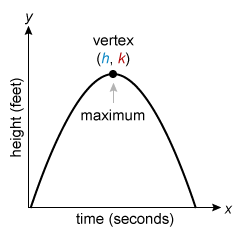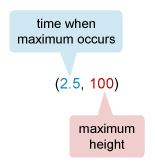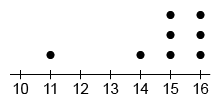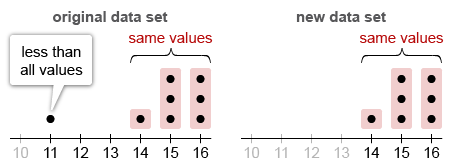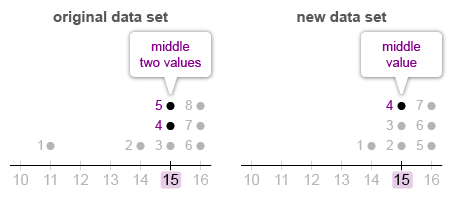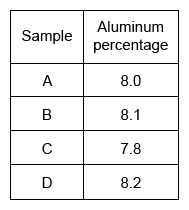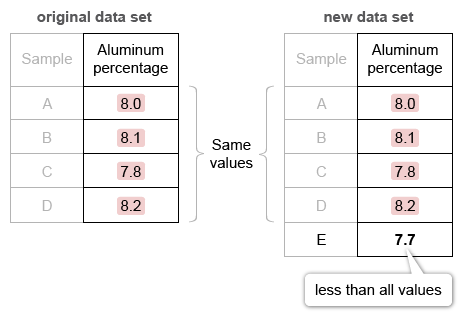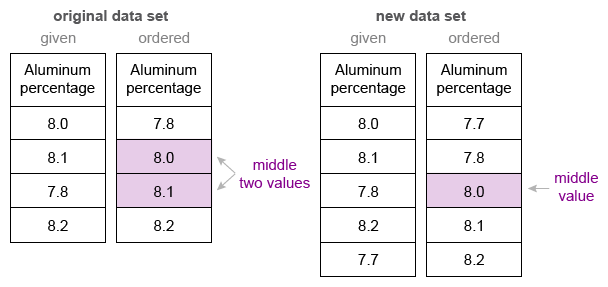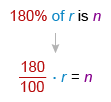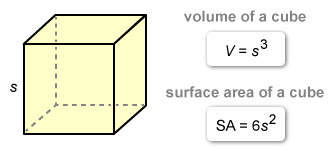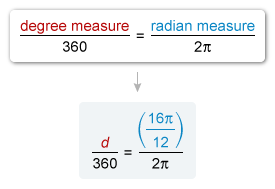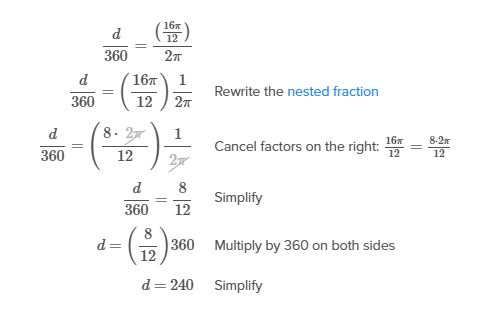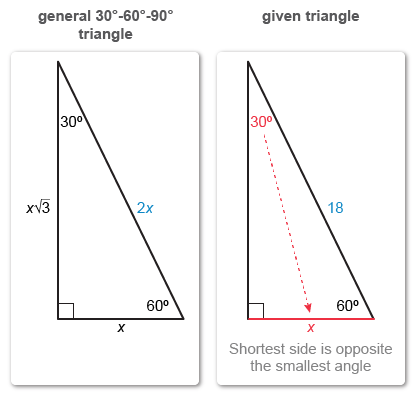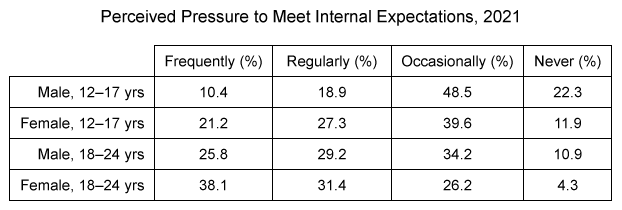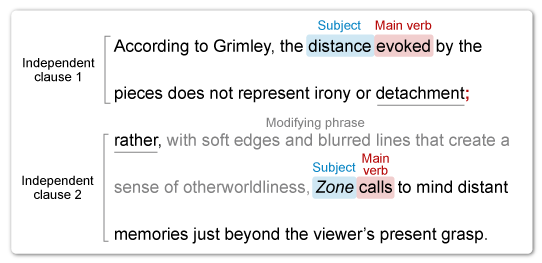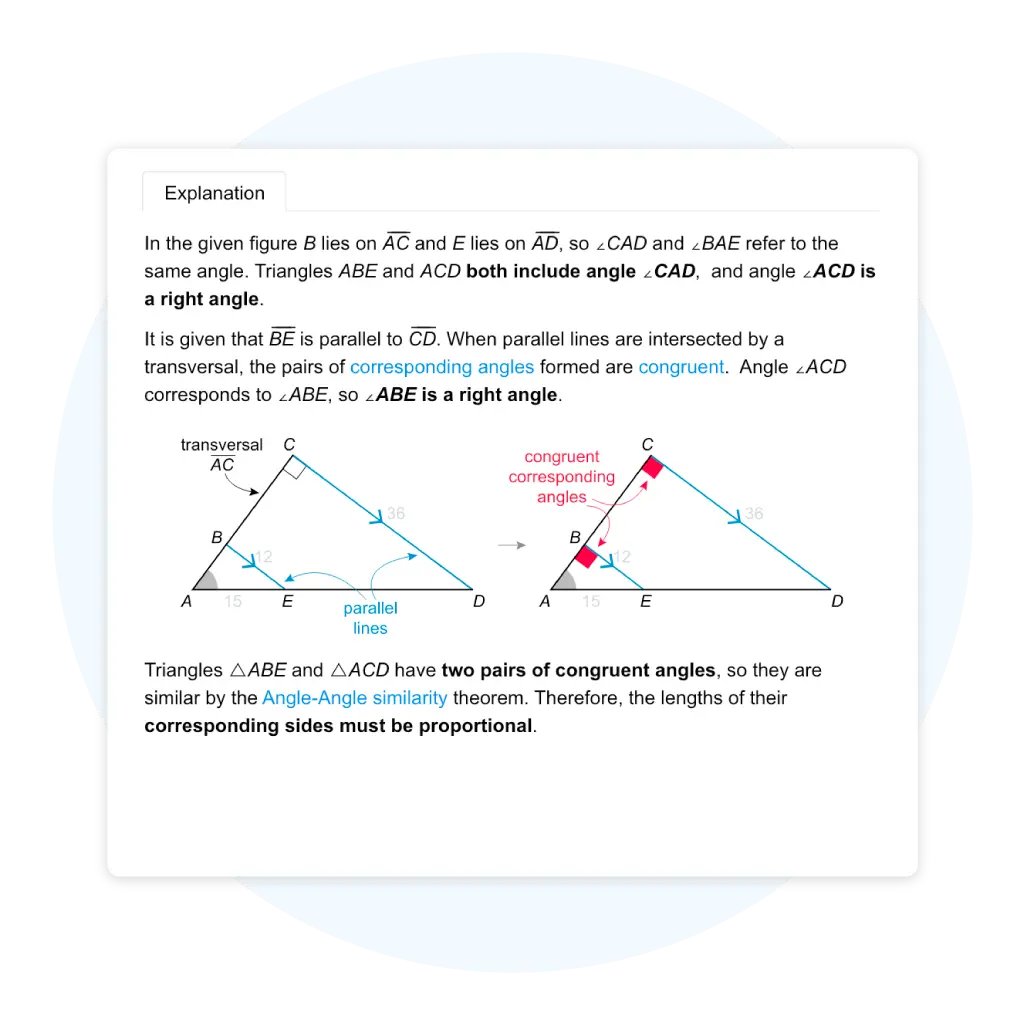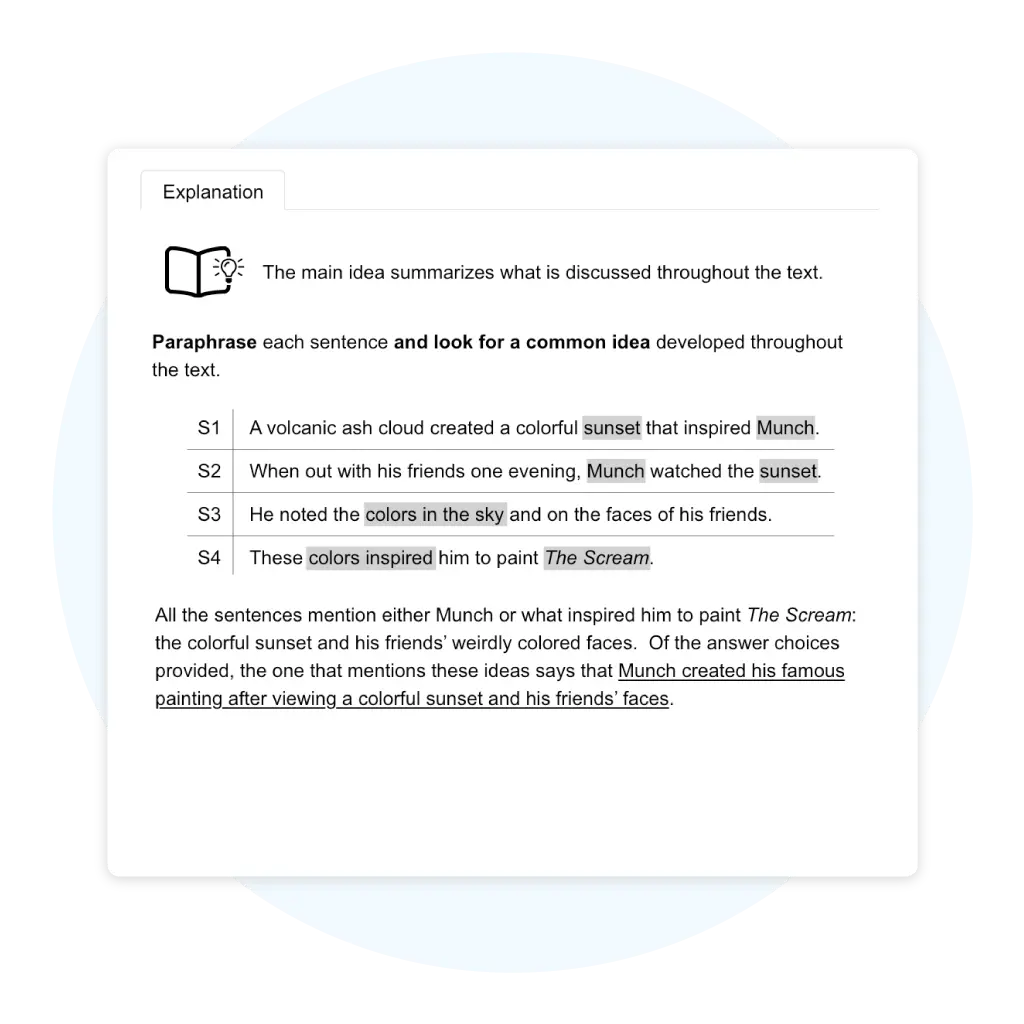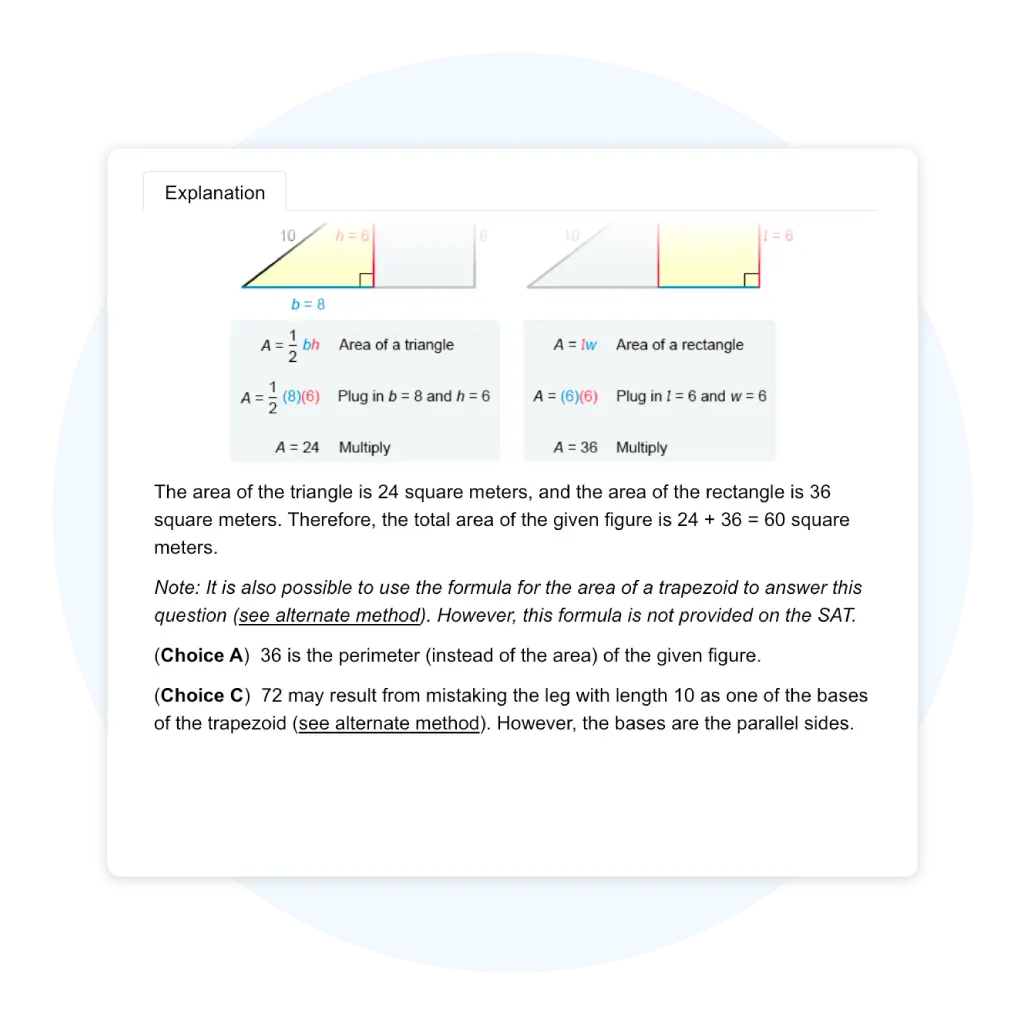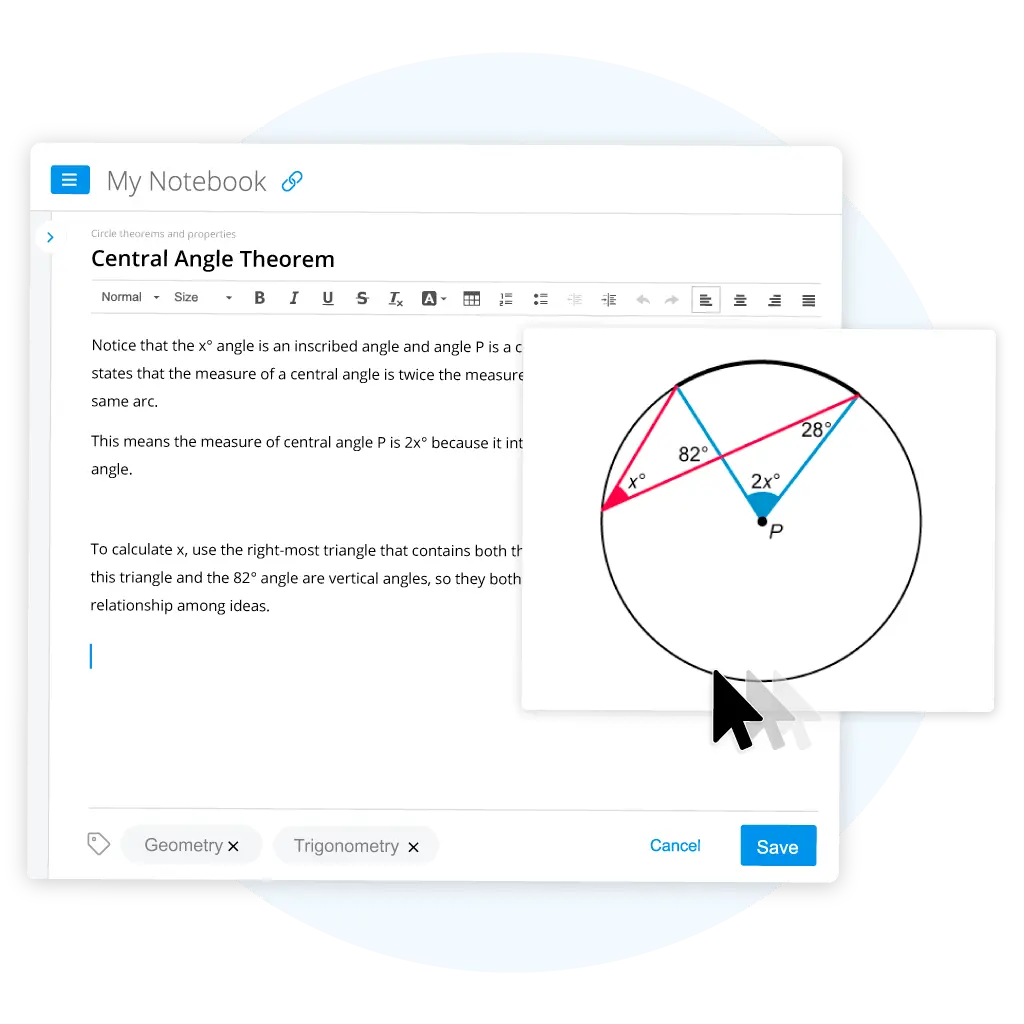SAT® Question Bank & Prep Questions (QBank)
Prep smarter—not longer. Access free SAT® practice questions that mirror the real exam with our free trial. Subscribe to unlock all 1,650+ SAT practice questions and answers, covering exactly what you’ll see on test day. Whether you prefer quick quizzes or comprehensive SAT question bank practice, UWorld’s digital SAT question bank is expertly crafted to help you study efficiently, boost your score, and feel confident on exam day.
Get a Taste of Smarter SAT® Practice Questions
SAT Math Practice Questions 1-3: Algebra
Question
Which of the following systems of linear equations has no solution?
| A.
x = −1
y = −1
|
|
| B.
y = 5 − 2x
y = −3
|
|
| C.
y = −3x
y = 5 − 3x
|
|
| D.
y = 1 − 4x
y = 1 + 4x
|
A system of linear equations has no solution if its graph consists of two parallel lines.
Explanation
A system of linear equations has no solution if its graph consists of two parallel lines because parallel lines never intersect.
Parallel lines have the same slope but different y-intercepts.
Notice that Choices A and B consist of a horizontal line (y = −1 and y = −3) and a line that is not horizontal, so these lines are not parallel. Eliminate Choices A and B.
Choices C and D are both in the form y = b + mx, where b is the y-intercept and m is the slope. Only Choice C has two equations with the same slope and different y-intercepts. Note: y = −3x is equivalent to y = 0 − 3x.
Therefore, the system of linear equations in Choice C has no solution (graph).
(Choice A) The graph of this system consists of a vertical line x = −1 and a horizontal line y = −1. It has exactly one intersection point, so it has exactly one solution (graph).
(Choice B) The graph of this system consists of the horizontal line y = −3 and the line y = 5 − 2x. It has exactly one intersection point, so it has exactly one solution (graph).
(Choice D) The graph of this system consists of two lines with different slopes and the same y-intercept. It has exactly one intersection point, so it has exactly one solution (graph).
Things to remember:
-
A system of linear equations has no solution if its graph consists of two parallel lines because parallel lines never intersect.
-
Parallel lines have the same slope but different y-intercepts.
Question
If the minimum value of r is 16 less than 8 times the value of x, which inequality shows the possible values of r ?
| A. r ≤ 8x − 16 | |
| B. r ≥ 8x − 16 | |
| C. r ≤ 16 − 8x | |
| D. r ≥ 16 − 8x |
The phrase "less than" means subtraction, and the word "times" means multiplication.
Explanation
It is given that the minimum value of r is 16 less than 8 times the value of x. Therefore, r must be greater than or equal to 16 less than 8 times the value of x.
Now build the expression on the right. The phrase "less than" means subtraction, and the word "times" means multiplication.
Therefore, the inequality that shows the possible values of r is r ≥ 8x − 16.
(Choice A) r ≤ 8x − 16 is incorrect because "r ≤" represents the maximum value of r, instead of the minimum value of r.
(Choice C) r ≤ 16 − 8x may result from the combination of errors described in Choices A and D.
(Choice D) r ≥ 16 − 8x is incorrect because "16 − 8x" represents 8x less than 16, instead of 16 less than 8x.
Things to remember:
- If the maximum value of a is b, then a must be less than or equal to b (a ≤ b).
- If the minimum value of a is b, then a must be greater than or equal to b (a ≥ b).
Question
Last week, a nonprofit organization recorded 1,980 items used for meal packs. The equation 4x + 10y = 1,980 represents this situation, where x is the number of snack packs and y is the number of dinner packs. Which of the following is the best interpretation of 10 in this context?
| A. There were 10 total items used in snack packs. | |
| B. There were 10 items used per snack pack. | |
| C. There were 10 total items used in dinner packs. | |
| D. There were 10 items used per dinner pack. |
To determine the best interpretation of 10 in the given context, first use the given information to determine the meaning of 10y.
Explanation
The given equation 4x + 10y = 1,980 represents the sum of the number of items used in snack and dinner packs that is equal to the given total items (1,980). To interpret 10, first find the meaning of 10y.
It is given that there were x snack packs, so 4x must represent the
number of items in snack packs.
It is given that there were y dinner
packs, so 10y must represent the number of items in dinner
packs.
The term 10y represents the number of items in dinner packs recorded by the organization, and the variable y represents the number of dinner packs.
Therefore, 10 must represent the number of items per dinner pack.
Therefore, the best interpretation of 10 is "There were 10 items used per dinner pack."
(Choice A) "There were 10 total items used in snack packs" may result from the combination of errors described in Choices B and C.
(Choice B) "There were 10 items used per snack pack" may result from mistaking 10 to represent snack pack items (instead of dinner pack items).
(Choice C) "There were 10 total items used in dinner packs" may result from mistaking 10 to represent all dinner items (instead of items per dinner pack).
Things to remember:
For an equation in the form Ax + By = C, the terms Ax and By are variable amounts whose sum is a total C.
SAT Math Practice Questions 4-6: Advanced Math
Question
An object, launched from a height of 0 feet, reaches a maximum height of 576 feet 6 seconds after launch. A quadratic function can be used to model the height, in feet, of the object above the ground in terms of time, in seconds, after launch. Based on the model, what is the height, in feet, of the object, 2 seconds after launch?
| A. 192 | |
| B. 320 | |
| C. 432 | |
| D. 560 |
The maximum of a quadratic function occurs at the vertex of its parabola. The vertex form of a quadratic function is f(x) = a(x − h)2 + k.
Explanation
It is given that the height of an object in terms of time is modeled by a quadratic function. To find the height of the object 2 seconds after launch, first write an equation for height f(x) in terms of time x.
The object is launched from height 0 and reaches its maximum height of 576 feet at 6 seconds. The maximum of a quadratic function occurs at the vertex of its parabola, so the given model has vertex (6, 576).
The vertex form of a quadratic function is f(x) = a(x − h)2 + k, where (h, k) is the vertex and a is the scale factor. Plug (h, k) = (6, 576) into vertex form.
| f(x) = a(x − h)2 + k | Vertex form |
| f(x) = a(x − 6)2 + 576 | Plug in (h, k) = (6, 576) |
Now find the value of a. The object was launched from a height of 0 feet, so f(x) = 0 when x = 0. Plug these values into f(x) = a(x − 6)2 + 576 and solve to find that a = −16.
Plug a = −16 into the equation for height f(x) in terms of time x.
| f(x) = a(x − 6)2 + 576 | |
| f(x) = −16(x − 6)2 + 576 | Plug in a = −16 |
Therefore, an equation that defines the given model is f(x) = −16(x − 6)2 + 576.
The height after 2 seconds is equal to f(2), the value of the function f when the time x is 2. Plug x = 2 into f(x) and solve for f(2).
| f(x) = −16(x − 6)2 + 576 | |
| f(2) = −16(2 − 6)2 + 576 | Plug in x = 2 |
| f(2) = −16(16) + 576 | Subtract and apply exponent: (2 − 6)2 = (−4)2 |
| f(2) = −256 + 576 | Multiply |
| f(2) = 320 | Simplify |
Based on the model, the height of the object 2 seconds after launch is 320 feet.
(Choice A) 192 may result from mistaking the function that represents the given scenario to be linear (instead of quadratic).
(Choice C) 432 is the height of the object 3 seconds after launch, but the question asks for the height 2 seconds after launch.
(Choice D) 560 may result from disregarding the scale factor a when attempting to write an equation that represents the given scenario in vertex form.
Things to remember:
-
The maximum or minimum of a quadratic function occurs at the vertex of its parabola.
-
The vertex form of a quadratic function is f(x) = a(x − h)2 + k, where (h, k) is the vertex and a is the scale factor.
Question
A rectangular diploma, shown above, has width 14 inches and length 11 inches and is surrounded by a wooden frame with a width of x inches. If the combined area of the diploma and the frame is 238 square inches, what is the value of x ?
| A. 1.5 | |
| B. 3 | |
| C. 6 | |
| D. 14 |
The formula for the area of a rectangle is , where is the length and is the width.
Explanation
It is given that a rectangular diploma has a length of 11 inches and a width of 14 inches and that its frame has a width of x inches. It is also given that the combined area of the diploma and frame is 238 square inches.
The formula for the area of a rectangle is A=lw is the width. where l is the length and w is the width. Use the given information to write an expression for the length and width of the framed diploma in terms of x.
The frame extends the length by x inches on both sides, so the framed diploma has
a length of
.
The frame extends the width by x inches on both sides, so the framed diploma has
a width of
.
Substitute these expressions for and and plug the given area of the framed diploma into the area formula to get an equation in terms of x.
To solve the resulting quadratic equation, first write the equation in standard form .
| Distribute each term in to each term in | |
| Combine like terms | |
| Subtract 238 from both sides |
To solve the resulting equation, factor by grouping or use the quadratic formula.
The value of x represents the width of the frame, so it cannot be negative. Therefore, the value of x must be 1.5 inches.
Note: To solve the equation , it is also possible to identify the x-intercepts on the graph of .
(Choice B) 3 may result from mistakenly adding only x (instead of 2x) to each dimension and solving , instead of .
(Choice C) 6 may result from mistakenly solving , instead of .
(Choice D) 14 may result from mistaking 14 (instead of −14) to be a solution to .
Things to remember:
- The formula for the area of a rectangle is , where is the length and is the width.
- It is possible to solve any quadratic equation in the form with the quadratic formula:
Question
The height of an object above the ground y, in feet, x seconds after it is launched from the ground is represented by a quadratic model. If the object reaches a maximum height of 100 feet 2.5 seconds after being launched, which equation could represent this model?
| A. y = −16(x + 2.5)2 + 100 | |
| B. y = −16(x − 2.5)2 + 100 | |
| C. y = −16(x + 100)2 + 2.5 | |
| D. y = −16(x − 100)2 + 2.5 |
Explanation
Notice that each choice is in vertex form , where (h, k) is the vertex and the scale factor a is −16. Therefore, it represents a parabola that opens downward and the vertex is a maximum.
It is given that x represents the time, in seconds, after the object is launched from the ground and that y represents the height, in feet, of the object above the ground.
It is also given that the object reaches a maximum height of 100 feet, 2.5 seconds after being launched, so the vertex is (2.5, 100).
Plug (h, k) = (2.5, 100) into to get an equation that represents this model.
| Plug in h = 2.5 and k = 100 |
The equation that represents this model is .
SAT Math Practice Questions 7-9: Problem-Solving and Data Analysis
Question
The dot plot represents the 8 values of a data set with a mean value of p and a median value of q. The value of 11 is removed to create a new data set of 7 values with a mean value of x and a median value of y. Which statement best compares the mean values and the median values of the two data sets?
| A. p = x and q < y | |
| B. p = x and q > y | |
| C. p < x and q = y | |
| D. p > x and q = y |
Hint :
Notice that the removed value of 11 is less than all the values in the original data set.
Data in a dot plot are ordered numerically.
Explanation
A dot plot shows how exact values are distributed over a range of data. On a dot plot, each dot represents a value in a data set. The question states that the value of 11 is removed to create a new data set.
Each choice compares the means and the medians of the two data sets, so analyze each of these measures.
Mean
If a value is added to or removed from a data set, the mean changes unless the value added or removed is equal to the mean.
It is given that the value 11 is removed from the data set. Notice that 11 is less than all the other values in the original data set.
The value 11 must be less than the mean of the original data set. When a value less than the mean is removed from a data set, the mean of the data set increases.
Therefore, the original mean (p) must be less than the new mean (x): p < x.
Median
The median of a numerically ordered data set with an odd number of values is the middle value, and the median of a data set with an even number of values is the average of the middle two values.
Data in a dot plot are ordered numerically. The original data set has 8 values (even), so the middle two are the 4th and 5th values. The new data set has 7 values (odd), so the middle is the 4th value.
The middle two values of the original data are 15 and 15, so the median of
the original data is 15.
The middle value of the new data set is 15, so the median of the new
data is 15.
Therefore, the original median (q) is equal to the new median (y): q = y.
Therefore, the statement that best compares the mean values and the median values of the two data sets is:
p < x and q = y
Note: Although not necessary to answer the question, it is possible to calculate and compare the mean of each data set.
Things to remember:
-
If a value is removed from a data set and the value is:
-
less than the mean, the mean will increase.
-
greater than the mean, the mean will decrease.
-
-
The median of a data set with an odd number of values is the middle value, and the median of a data set with an even number of values is the average of the middle two values.
Question
A geologist has collected four samples of Earth's crust. The table shows the percentage of aluminum in each of the four samples. The geologist collects a fifth sample with an aluminum percentage of 7.7. Which of the following correctly describes how the mean and the median aluminum percentage will change when the fifth sample is added?
| A. The mean and the median will decrease. | |
| B. The mean and the median will increase. | |
| C. The mean will decrease, and the median will remain the same. | |
| D. The mean will increase, and the median will remain the same. |
Hint :
Notice that the aluminum percentage of the added sample (7.7) is less than all the values in the original collection of samples.
The median of a data set with an odd number of values is the middle value, and the median of a data set with an even number of values is the average of the middle two values.
Explanation
The question asks about the mean and the median aluminum percentage if a fifth sample of Earth's crust is added to the geologist's data.
Consider the percentages of the 4 samples to be the original data set and those of the 5 samples to be a new data set. Compare the means and medians separately.
mean
If a value is added to or removed from a data set, the mean changes unless the value added or removed is equal to the mean.
It is given that a fifth sample with an aluminum percentage of 7.7 is added to the data set. Notice that 7.7 is less than all the other aluminum percentages among the original 4 samples.
Therefore, 7.7 must be less than the mean of the original data set. When a value less than the mean is added to a data set, the mean of the data set decreases.
median
The median of a numerically ordered data set with an odd number of values is the middle value, and the median of a data set with an even number of values is the average of the middle two values.
The original data set has 4 values (even), and the new data set has 5 values (odd). Notice that the values are not ordered numerically, so order the original and new values from least to greatest.
The middle two values of the original set are 8.0 and 8.1, so the median is their
average:
.
The middle value of the new set is 8.0, so the median is 8.0.
The median decreases as a result of the added sample.
Therefore, the statement that best describes how the mean and the median aluminum percentage will change when the fifth sample is added is:
The mean and the median will decrease.
Note: Although not necessary to answer the question, it is possible to calculate and compare the mean of each data set.
Things to remember:
- If a value is added to a data set and the value is:
- less than the mean, the mean will decrease.
- greater than the mean, the mean will increase.
- The median of a data set with an odd number of values is the middle value, and the median of a data set with an even number of values is the average of the middle two values.
Question
If 180% of r is n, which expression represents r in terms of n ?
| A. 5n 9
|
|
| B. 9n 5
|
|
| C. n 180
|
|
| D. 180n
|
Hint :
Explanation
To find the expression that represents r in terms of n, first use the given information to write an equation in terms of r and n.
It is given that 180% of r is n. A percent of a number is equal to the percent as a fraction multiplied by that number. Rewrite 180% as , then multiply by r and set the result equal to n.
Now isolate r to get an expression for r in terms of n.
| Multiply by 100 on both sides | |
| Divide by 180 on both sides and simplify |
Therefore, the expression that represents r in terms of n is .
(Choice B) is an expression for 180% of n, but the question states that 180% of r is n.
(Choice C) may result from the misconception that 180% is equivalent to the value 180 (instead of ).
(Choice D) may result from the combination of errors described in Choices B and C.
Things to remember:
- To find p% of a number, multiply the number by .
- To express a variable in terms of the other variables in an equation, isolate that variable so that it appears by itself on one side of the equation.
SAT Math Practice Questions 10-12: Geometry and Trigonometry
Question
The surface area of a cube is 96 square centimeters. What is the volume, in cubic centimeters, of the cube?
| A. 16 | |
| B. 24 | |
| C. 48 | |
| D. 64 |
A cube is a rectangular prism with 6 congruent square faces.
First use the formula for the surface area of a cube to solve for the edge length.
Explanation
A cube is a rectangular prism with 6 congruent square faces, so its edges are all the same length. The formula for the volume of a cube with edge length s is V = s3 (proof).
The formula for the surface area (SA) of a cube with edge length s is SA = 6s2 (proof).
Use the given surface area (96) to solve for the edge length s, and then calculate the volume of the cube.
Plug SA = 96 into the formula for the surface area of a cube and solve for s.
| SA = 6s2 | Surface area of a cube |
| 96 = 6s2 | Plug in SA = 96 |
| 16 = s2 | Divide by 6 on both sides |
| 4 = s | Take the positive square root (length is positive) |
The edge length of the cube is 4 centimeters.
Plug s = 4 into the formula for the volume of a cube.
| V = s3 | Surface area of a cube |
| V = 43 | Plug in s = 4 |
| V = 64 | Apply the exponent: 43 = 4 ∙ 4 ∙ 4 |
The volume of the cube is 64 cubic centimeters.
(Choice A) 16 may result from mistaking the formula for the volume V of a cube to be s2 (instead of V = s3).
(Choice B) 24 may result from mistaking the formula for the volume V of a cube to be 6s (instead of V = s3).
(Choice C) 48 may result from incorrectly evaluating 43 as 4 ∙ 4 ∙ 3 (instead of 4 ∙ 4 ∙ 4).
Things to remember:
- The formula for the volume V of a cube with edge length s is V = s3.
- The formula for the surface area SA of a cube with edge length s is SA = 6s2.
Question
Angle P has a measure of radians. If the measure of angle Q is radians greater than the measure of angle P, what is the measure of angle Q, in degrees?
| A. 30 | |
| B. 105 | |
| C. 135 | |
| D. 240 |
Hint :
The angle measure of a complete circle is 360°, or 2π radians.
For any angle, the ratio of its degree measure to 360° must equal the ratio of its radian measure to 2π radians.
Explanation
An angle can be measured in radians or degrees. A complete circle contains 2π radians, or 360°.
It is given that the measure of angle Q is radians greater than that of angle P, and that the measure of angle P is radians. Add to find the radian measure of angle Q.
To add fractions, first rewrite them with a common denominator.
The radian measure of angle Q is radians. Let d be the equivalent degree measure and set up a proportion.
For any angle, the ratio of the degree measure to 360° must equal the ratio of the radian measure to 2π radians. Plug in the given radian measures and then solve the proportion.
Now solve for d.
The measure of angle Q is 240 degrees.
Note: It is also possible to first find the degree measure for each angle, and then add 105 and 135 to find that the degree measure of angle Q is 240.
(Choice A) 30 may result from finding the degree measure that is 3π4 radians less than (instead of greater than) the measure of angle P.
(Choice B) 105 is the degree measure that is equivalent to 7π12 radians, but angle Q is 3π4 radians greater than 7π12 radians.
(Choice C) 135 is the degree measure that is equivalent to 3π4 radians, but angle Q is 3π4 radians greater than 7π12 radians.
Things to remember:
The ratio of the degree measure of an angle to 360° must be equal to the ratio of the radian measure of the same angle to 2π radians.
To convert from radians to degrees, it is also possible to multiply by a conversion factor that cancels the old unit and replaces it with the new unit.
A conversion factor is a fraction that is equivalent to 1, so it changes only the units and not the quantity. Use a fraction with the new unit in the numerator and the old unit in the denominator.
The radian measure of angle Q is (see main explanation). To convert from radians to degrees, multiply by a fraction with degrees in the numerator and the equivalent number of radians in the denominator.
The conversion is 360° = 2π radians, so the conversion factor is . Cancel radians and simplify to find that radians is equivalent to 240 degrees.
The measure of angle Q is 240 degrees.
Note: It is possible to use an equivalent conversion 180° = π radians when converting between degrees and radians.
Things to remember:
- To convert from one unit to another, multiply by a conversion factor that cancels the old unit and replaces it with the new unit.
- The conversion between degrees and radians is 360° = 2π radians or 180° = π radians.
Question
A triangle has interior angles with measures in the ratio of 1:2:3. If the longest side length of the triangle is 18, what is the length of the shortest side?
| A. 6 | |
| B. 9 | |
| C. 9√2 | |
| D. 9√3 |
Use the ratio 1:2:3 to write the degree measures of the three angles as 1k, 2k, and 3k, where k is the measure of the smallest angle.
Then set the sum of these angles equal to 180° because the measures of the interior angles of a triangle add to 180°.
Explanation
Use the ratio 1:2:3 to write the degree measures of the three angles as 1k, 2k, and 3k, where k is the measure of the smallest angle.
The interior angles of a triangle add to 180°, so set the sum of the three angle measures equal to 180 and solve for k.
| 1k + 2k + 3k = 180 | Interior angles in a triangle sum to 180° |
| 6k = 180 | Combine terms on the left |
| k = 30 | Divide both sides by 6 to solve for k |
The measure of the 1k angle is 30°. Plug k = 30° into 2k and 3k to find that the measures of the other two angles are 2k = 60° and 3k = 90°. Therefore, the triangle is a 30°-60°-90° triangle.
In a right triangle, the longest side is the hypotenuse. The given length of the longest side is 18, so the length of the hypotenuse is 18. The hypotenuse is twice the length of the shorter leg in a 30°-60°-90° triangle.
Set the hypotenuses equal to calculate the length of the shortest side x.
| 18 = 2x | Set the hypotenuses equal |
| 9 = x | Divide both sides by 2 to solve for x |
Therefore, the hypotenuse (18) is twice the length of the shorter side. Divide 18 by 2 to find that the length of the shorter side is 9.
(Choice A) 6 may result from incorrectly setting 1:2:3 equal to the ratio of side lengths, instead of angle measures.
(Choice C) may result from mistakenly dividing the length of the hypotenuse by , instead of 2. This may result from mistaking the triangle to be a 45°-45°-90° right triangle, instead of a 30°-60°-90° right triangle.
(Choice D) is the length of the longer leg of the right triangle.
Things to remember:
- The measures of the interior angles of a triangle add to 180°.
- The shortest side of a triangle is opposite the smallest angle in that triangle. Similarly, the longest side is opposite the largest angle in that triangle.
- The side lengths of a 30°-60°-90° special right triangle are in the ratio .
SAT Reading & Writing Questions 1-3: Information and Ideas
Passage
Researchers in the Netherlands were interested in determining whether age and gender influenced an individual's personal pressure to meet internal expectations. In 2021, these researchers recruited both adolescents and young adults, asking them how often they perceived pressure to meet their own expectations. Interestingly, they found that responses varied greatly depending on the participant's age and gender; for example, ______
Question
Which choice most effectively uses data from the table to complete the example?
| A. 21.2% of females ages 12–17 reported frequently perceiving pressure, whereas 11.9% of females in that same age group reported never perceiving pressure. | |
| B. 38.1% of females ages 18–24 reported frequently perceiving pressure as compared with 10.4% of males ages 12–17 who reported frequently perceiving pressure. | |
| C. 48.5% of males ages 12–17 reported occasionally perceiving pressure to meet internal expectations, which is the largest percentage of any of the categories. | |
| D. 31.4% of females ages 18–24 reported regularly perceiving pressure, which is similar to the 29.2% of males ages 18–24 who reported regularly perceiving pressure. |
Explanation
Analyze the sentence containing the blank to determine what's being discussed. The correct answer will contain details related to the text and reinforced with information from the table.
 |
Although each answer may accurately describe data in the table, choose the one that is the best example of what the sentence is discussing. |
The sentence with the blank states there was a great difference in responses based on the age and the gender (male or female) of the participants. Therefore, the correct answer must give an example of this difference.
Because it shows the highest percentage difference—almost 30%—between females and males in different age groups, the correct answer is that 38.1% of females ages 18–24 reported frequently perceiving pressure as compared with 10.4% of males ages 12–17 who reported frequently perceiving pressure.
(Choice A) This answer is incorrect because it doesn't show a difference in responses depending on gender; it shows only a difference in the perceived pressure within the same age group of females.
(Choice C) This answer mentions only the percentage of one group of males, so it doesn't show a difference in responses based on either age or gender.
(Choice D) Although this answer references a difference in gender, there's not a big difference—about 2%—between 31.4% and 29.2%.
Things to remember:
Examine the sentence with the blank to determine what information from the table completes it.
Passage
Fashion in cinema communicates background information about a film's setting to its intended audience. For instance, African American costume designer Ruth E. Carter integrates traditional African tribal styles, fabrics, and accessories with more futuristic designs to depict settings that are not only rich in history but also technologically advanced. But understanding the historical significance of the traditional fashions may require study of the tribes from which these styles originated. Consequently, _______
Question
Which choice most logically completes the text?
| A. many moviegoers are less likely to appreciate the importance of Carter's traditional costume elements than her futuristic designs. | |
| B. some of Carter's costume designs reveal more about the setting than they do the characters. | |
| C. Carter's costumes have been the most successful in recent years in blending traditional and futuristic designs. | |
| D. film costume historians suggest that Carter's traditional designs have been her best work. |
Explanation
 |
Transitions connect the ideas in surrounding sentences. |
Determine the meaning of the conjunctive adverb that completes the text. Then, use its meaning to relate the information in the previous sentence with the answer that must follow.
"Consequently" indicates that the correct answer will include a logical conclusion based on previous information. In the preceding sentence, the text claims that people without knowledge of African tribes may not understand the traditional designs' historical importance.
Therefore, the answer that best offers a consequence (result) of this idea states that many moviegoers are less likely to appreciate the importance of Carter's traditional costumes than her futuristic designs.
(Choice B) The text notes Carter's designs reveal details of the setting in the films she works on, but you cannot draw a conclusion from the text about how effectively the costumes reveal details about the setting or the characters.
(Choice C) The text discusses Carter's approach in blending styles but does not discuss whether she has recently been more successful with this approach.
(Choice D) The text does not mention the opinions of film costume historians.
Things to remember:
When completing a sentence that begins with a conjunctive adverb, choose the answer containing ideas that would logically follow based on the relationship the adverb establishes.
Passage
"The Tuft of Flowers" is an early 1900s poem by Robert Frost. In the poem, the speaker discusses a sense of solitude followed by a personal reflection: ______
Question
Which quotation from "The Tuft of Flowers" most effectively illustrates the claim?
| A. "I went to turn the grass once after one / Who mowed it in the dew before the sun. / The dew was gone that made his blade so keen / Before I came to view the leveled scene." | |
| B. "A leaping tongue of bloom the scythe had spared / Beside a reedy brook the scythe had bared. / I left my place to know them by their name, / Finding them butterfly weed when I came." | |
| C. "And dreaming, as it were, held brotherly speech / With one whose thought I had not hoped to reach. / 'Men work together,' I told him from the heart, / 'Whether they work together or apart.'" | |
| D. "But he had gone his way, the grass all mown, / And I must be, as he had been,—alone, / 'As all must be,' I said within my heart, / 'Whether they work together or apart.'" |
Explanation
Find the quote from the poem that matches the claim: the speaker discusses a sense of solitude followed by personal reflection.
| "But he had gone his way, the grass all mown, | But the other worker had left after mowing the grass, |
| And I must be, as he had been,—alone, | And I was left by myself like he had been, |
| 'As all must be,' I said within my heart, | And I thought to myself, "All people are alone," |
| 'Whether they work together or apart.'" | "No matter whether they work alongside someone or by themselves." |
The speaker mentions being alone, which shows a sense of solitude (aloneness; isolation). His personal reflection is his thought to himself that everybody is alone even when working with others. Because it contains the claim's idea that a sense of solitude is followed by a personal reflection, the right answer is Choice D.
(Choices A, B, and C) The speaker offers personal reflections in all of these lines, but despite the fact that he is the only person there, he doesn't express feelings of solitude in any of them. Therefore, none of these answers support the claim.
-
Choice A: These lines indicate the speaker's realization that the mower had been there earlier before he arrived.
-
Choice B: These lines indicate that the speaker notices some flowers that the mower left, and he identifies them as butterfly weed.
-
Choice C: These lines show the speaker imagining what he would say to the mower about brotherhood.
Things to remember:
Paraphrase each set of lines to determine which ones contain the ideas referred to by the question's claim.
SAT Reading & Writing Questions 4-6: Craft and Structure
Passage
Navajo filmmaker Sydney Freeland ______ a television newscast's past characterization of Gallup, New Mexico, as "Drunk Town, USA": this denial is clear in her movie Drunktown's Finest, which tells the stories of three non-alcoholic Navajo Native Americans living on an Indian reservation bordering this town.
Question
Which choice completes the text with the most logical and precise word or phrase?
| A. rejects | |
| B. broadcasts | |
| C. prophesies | |
| D. retracts |
Explanation
Look for wording in the text that indicates the best answer.
The information after the colon supports the idea that comes before it. The words "this denial" support Freeland's idea about Gallup, New Mexico, not being accurately characterized as "Drunk Town, USA." In response, her film tells the stories of three Navajo Native Americans who live in the area but who are not drunks.
Rejects = refuses to accept. (Ex. Maribel rejects any negative comments about her ancestors.) Because refusing to accept something is a type of denial, the most logical and precise word to complete the text is rejects.
(Choice B) Broadcasts = makes widely known. (Ex. The politician broadcasts his opponent's flaws.) The text indicates with "this denial" that Freeland doesn't agree with the newscast's portrayal of the town, so she would have no motivation to make it widely known.
(Choice C) Prophesies = predicts a future occurrence. (Ex. The fortune teller prophesies that I will find love this year.) The text makes it clear that the newscast's characterization of the town was released in the past, so Freeland would have no need to predict what the newscast will say.
(Choice D) Retracts = takes back. (Ex. The spokesperson retracts her incorrect statements only when she gets new information.) Because it's the television newscast, not Freeland, who claims that Gallup is "Drunk Town, USA," she can't be the one to take it back. Instead, she counters the claim with a film offering an alternate perspective.
Things to remember:
Find wording in the text that offers a clue to the right answer.
Passage
The following text is from Willa Cather's 1905 short story "Paul's Case."
Paul was tall for his age and very thin, with high, cramped shoulders and a narrow chest. His eyes were remarkable for a certain hysterical brilliancy, and he continually used them in a conscious, theatrical sort of way, peculiarly offensive in a boy. The pupils were abnormally large, as though he were addicted to belladonna, but there was a glassy glitter about them which that drug does not produce. When questioned by the principal as to why he was there, Paul stated, politely enough, that he wanted to come back to school.
Question
Which choice best states the function of the underlined sentence in the text as a whole?
| A. It transitions to the character description in the sentence that follows. | |
| B. It creates a contrast with the description in the previous sentence. | |
| C. It continues the previous sentence's description of a character. | |
| D. It introduces a setting that is described in the sentence that follows. |
Explanation
To identify the function of a sentence, examine the other sentences in the text and see how they are related.
The underlined sentence indicates that Paul's pupils are "abnormally large" with a "glassy glitter." Because the previous sentence also describes Paul's eyes as having a "hysterical brilliancy," the underlined sentence continues the previous sentence's description of the character.
(Choice A) A transition shows the relationship between two sentences, but the description of Paul's eyes as large and glittering does not establish a connection between his appearance as described in the sentence before it and the politeness that is shown in the one after it.
(Choice B) The "brilliancy" of Paul's eyes in the previous sentence and their "glassy glitter" in the underlined sentence provide similar descriptions.
(Choice D) The underlined sentence only describes Paul's eyes in more detail. However, Paul's appearance doesn't introduce the school setting that is implied in the following sentence.
Things to remember:
Evaluate every sentence in the text to determine the purpose of a sentence.
Passage
White sharks, along with only 34 species of fish, can warm their muscles, a seemingly insignificant trait that evolved in less than 0.1% of fish. However, because muscles become more powerful when they are warm, some scientists hypothesize that this ability isn't ______; rather, the greater power from warmed muscles provides important increases in speed and travel distance, making these fish better hunters and allowing them more feeding and reproduction opportunities.
Question
Which choice completes the text with the most logical and precise word or phrase?
| A. persistent | |
| B. practicable | |
| C. consequential | |
| D. trivial |
Explanation
Identify words in the text that provide clues to which answer best fits what's being discussed.
The first sentence states that a fish's ability to warm its muscles is "seemingly insignificant" (not important). The next sentence, however, presents the opposite idea, explaining that warmed muscles provide an important benefit—"greater power" that makes these fish "better hunters."
Despite how it seems, an ability that gives fish advantages in feeding and reproduction is significant. However, the word "isn't" (is not) before the blank indicates that the missing word describing their ability must mean the opposite of "significant." Because it means not significant, the correct answer is trivial.
 |
Carefully note the wording before a blank. Words like "not" indicate that the missing word will express the opposite of what the text describes. |
(Choice A) "Persistent" means relentless or lasting without change. The text doesn't discuss whether the ability of some fish to warm their muscles changes over time, so this statement isn't supported by the text.
(Choice B) "Practicable" means able to be used. The text states that 35 fish species ARE able to warm their muscles to improve their hunting and travel distances.
(Choice C) "Consequential" means important or significant. However, it would be incorrect to say the ability to warm their muscles isn't consequential because the text explains that muscle-warming has important consequences for their feeding and reproduction.
Things to remember:
Use the clues provided by the text to find the answer that best fits with the context.
SAT Reading & Writing Questions 7-9: Expression of Ideas
Passage
Many animals have developed unique defenses to avoid being eaten by predators. The Australian bombardier beetle (Pheropsophus verticalis), ______ can deter would-be attackers by releasing a rapid burst of hot, noxious fluid from its abdomen.
Question
Which choice completes the text with the most logical transition?
| A. despite this, | |
| B. however, | |
| C. for instance, | |
| D. therefore, |
Explanation
Determine how the idea in the second sentence relates to what's discussed in the first sentence. Then, select a transition that shows that relationship.
"For instance" is used to indicate an example that clarifies or supports a previous assertion. In this case, the first sentence asserts that animals use "unique defenses" to keep from being eaten. The second sentence provides an example of such a defense: "releasing a rapid burst of hot, noxious fluid."
For instance, then, is the best transition to show the relationship between these two sentences.
(Choice A) "Despite this" means "nonetheless" or "nevertheless" and can introduce an idea that may be unexpected because it isn't based on previously stated information. Rather than being unexpected, the "noxious fluid" is an example of "unique defense."
(Choice B) "However" is used to show an idea that contrasts with one previously presented. Because the "noxious fluid" is an example of "unique defenses," the ideas are similar, so "however" wouldn't accurately show their relationship.
(Choice D) "Therefore" shows a conclusion based on a previous statement. The fact that the beetles release "noxious fluid" isn't a conclusion that can be drawn from the fact that some animals have "unique defenses." Rather, it is a specific example of such a defense.
Things to remember:
The best transition to connect two sentences is the one that accurately indicates how their ideas are related.
Passage
In the 1970s, US ecologist Gene Likens found that harmful acid rain was caused by emissions of nitrogen and sulfur oxides from fossil fuel combustion. His work was instrumental in efforts to curb these emissions in the US. _____ it led to the 1990 legislation that set a national cap on nitrogen and sulfur oxide emissions from power plants.
Question
Which choice completes the text with the most logical transition?
| A. Nevertheless, | |
| B. In particular, | |
| C. On the other hand, | |
| D. Previously, |
Explanation
Compare the ideas before and after the blank to determine how they are related. Then, choose the transition that best expresses that relationship.
His work was instrumental in efforts to curb these emissions in the US. _____ it led to the 1990 legislation that set a national cap on nitrogen and sulfur oxide emissions from power plants.
The sentence before the blank makes the general claim that Likens's work was important in limiting certain fossil fuel emissions. The sentence after the blank identifies a specific outcome from his work: A law was passed to set a limit on emissions. Thus, the sentence before the blank contains a general claim, and the sentence after provides a specific example supporting that claim.
The transition "in particular" introduces a specific example of a previous idea. Therefore, in particular, is correct.
(Choices A, C, and D) These choices don't express the transition from a general claim to a specific example.
-
Choice A: "Nevertheless" shows contrast with a previous idea. (Ex. The hike was exhausting. Nevertheless, it was worth it for the view.)
-
Choice C: "On the other hand" expresses an alternative or opposing idea. (Ex. Traveling can be stressful. On the other hand, it can provide enriching experiences.)
-
Choice D: "Previously" indicates something that happened at an earlier time. (Ex. This summer, I flew on an airplane. Previously, I had always traveled by car.)
Things to remember:
Compare the ideas around the blank to determine the relationship between them. Select the transition that expresses that relationship.
Passage
In his monumental exhibition The Weather Project, Danish Icelandic artist Olafur Eliasson creates a deceptively simple illusion that is both thought-provoking and humbling. _____ as visitors see themselves reflected alongside the vast sun in the mirrored ceiling, they are prompted to ponder their relationship with the natural world and to consider how insignificant they are in relation to the magnificent sky.
Question
Which choice completes the text with the most logical transition?
| A. Besides, | |
| B. Regardless, | |
| C. Indeed, | |
| D. However, |
Explanation
Compare the information provided before and after the blank to determine the relationship between the two sentences. Then, choose the transition word that expresses that relationship.
The first sentence introduces an art exhibition, The Weather Project, and claims that it is "both thought-provoking and humbling." The second sentence provides details to support this idea by describing how the artwork achieves this effect: viewers "ponder their relationship with the natural world" (thought-provoking) and "consider how insignificant they are" (humbling).
As a transition, "indeed" introduces information that emphasizes and supports a preceding idea. Because the second sentence supports the ideas stated in the first, indeed, is correct.
(Choices A, B, and D) None of these words introduce information that supports a previous idea.
- Choice A: "Besides" introduces new information that adds to the previous idea but goes in a different direction. (Ex. I'm not going to the party because it starts too late. Besides, I won't know anyone there.)
- Choice B: "Regardless" indicates that the following statement is true despite the ideas in the previous statement. (Ex. The weather forecast predicted rain. Regardless, we decided to go hiking.)
- Choice D: "However" signals a contrast. (Ex. The team played well. However, they still lost the game.)
Things to remember:
Identify the relationship between sentences and select the transition that reflects that relationship.
SAT Reading & Writing Questions 10-12: Standard English Conventions
Passage
In 2020, an international team of astronomers led by Jane Greaves reported that the Atacama Large Millimeter/submillimeter Array (ALMA) helped them detect the presence of phosphine in the atmosphere of Venus. A cosmically rare (but, as it turns out, terrestrially common) molecule, ______
Question
Which choice completes the text so that it conforms to the conventions of Standard English?
| A. which could indicate possible life on Venus, a level of approximately 20 parts per billion (ppb) of phosphine was found. | |
| B. a level of approximately 20 parts per billion (ppb) of phosphine, which could indicate possible life on Venus, was found. | |
| C. finding phosphine at a level of approximately 20 parts per billion (ppb) could indicate possible life on Venus. | |
| D. phosphine was found at a level of approximately 20 parts per billion (ppb), which could indicate possible life on Venus. |
Explanation
Rule: When a phrase that describes a noun or pronoun appears at the start of sentence before a comma, the noun or pronoun being described should directly follow.
Because the introductory phrase is an appositive, choose the answer that begins with a noun that could be described by that appositive.
The first sentence says that astronomers found phosphine on Venus. The next sentence begins with the appositive that refers to a “cosmically rare… molecule.” Because the appositive describes a molecule, the correct answer must begin with a noun that could be a molecule.
The only possible molecule in the text is phosphine, so the answer is phosphine was found at a level of approximately 20 parts per billion (ppb), which could indicate possible life on Venus.
(Choices A, B, and C) None of these answers begin with a noun that could be referred to as "a cosmically rare…molecule."
Choice A: Begins with “which,” a relative pronoun that further describes the molecule but doesn't name the noun being described.
Choice B: The "level" of parts per billion is a noun, but it isn't a "molecule."
Choice C: "Finding" in this answer is a gerund, so it functions as a noun; however, since it refers to an action rather than a "molecule," it isn't the correct word to follow the introductory appositive.
Things to remember:
When the introductory information is an appositive, the first noun after the comma must be what is
referred to by that appositive.
Passage
In his analysis of Matvey Levenstein's 2024 collection of paintings titled Zone, art historian Alex Grimley emphasizes the theme of distance. According to Grimley, the distance evoked by the pieces does not represent irony or ______ with soft edges and blurred lines that create a sense of otherworldliness, Zone calls to mind distant memories just beyond the viewer's present grasp.
Question
Which choice completes the text so that it conforms to the conventions of Standard English?
| A. detachment | |
| B. detachment; rather, | |
| C. detachment, | |
| D. detachment, rather, |
Explanation
Rule: Semicolons can separate consecutive independent clauses in the same sentence, and a transition word may be placed between clauses separated by a semicolon.
Identify the clauses surrounding the blank by locating the subjects and main verbs. Then, choose the answer with punctuation and wording that correctly separates the clauses.
The information before the blank contains a subject and a main verb and forms an independent clause. The information after the blank begins with a modifying phrase that leads into another independent clause.
The only answer that provides correct punctuation between the two independent clauses uses a semicolon and a transition word, making detachment; rather, correct.
(Choice A) This answer has no punctuation between the clauses, which creates a run-on error.
(Choices C and D) A comma between independent clauses must be followed by a FANBOYS conjunction. Because there is no FANBOYS conjunction in these choices, each of these creates a comma splice error.
Things to remember:
Independent clauses in the same sentence may be separated by a semicolon, and a transition word may appear between them.
Passage
An important regulatory body that protects public health by overseeing food and medicine in the United States, ______.
Question
Which choice completes the text so that it conforms to the conventions of Standard English?
| A. the Food and Drug Administration (FDA) was also responsible for toy safety between 1966 and 1973. | |
| B. toy safety was what the Food and Drug Administration (FDA) was responsible for between 1966 and 1973. | |
| C. 1966 and 1973 were the years between which the Food and Drug Administration (FDA) was also responsible for toy safety. | |
| D. responsibility for toy safety was held by the Food and Drug Administration (FDA) between 1966 and 1973. |
Explanation
Rule: When an appositive phrase describing a noun or pronoun begins a sentence and ends with a comma, the noun or pronoun being described should follow directly afterward.
Note that there is an appositive phrase before the comma that mentions—but does not name—"an important regulatory body." Because an introductory appositive must be followed by the noun it refers to, select the answer that begins with a noun or pronoun that could be described as a regulatory body.
A regulatory body is a government organization that enforces certain rules and standards. The only noun in the answer choices that fits that description is "the Food and Drug Administration."
Therefore, this noun must begin the independent clause after the comma, making the correct answer the Food and Drug Administration (FDA) was also responsible for toy safety between 1966 and 1973.
(Choices B, C, and D) None of these answers begins with a noun that could be considered "an important regulatory body." "Toy safety," "1966 and 1973," and "responsibility" are not the names of organizations.
Things to remember:
The first noun after an introductory appositive phrase must be the
noun that is being described by that introductory information.
Need More SAT Practice Questions to Boost Your Score?
Strategic SAT Practice Questions: Get Real Results, Fast.
Go beyond one-size-fits-all generic questions. Our QBank is a strategic tool designed to help you quickly master the true feel of the digital SAT, precisely target your exact weaknesses, and learn from every single mistake.
Practice at
Test Day
Difficulty
Strengthen Your Weakest Skills
Understand Why You’re Wrong
Our SAT QBank: Learn From Every Question
Answering endless questions can feel like progress, but TBH, mindlessly doing questions is the doom-scrolling of test prep. True score growth comes from learning. Our QBank is built around the "incredibly detailed and helpful" explanations that students praise online, giving you the tools to learn from every single mistake.
See the "Why" Behind Every Wrong Answer
Stop getting frustrated by "terrible" explanations that just show the right answer. We show you step-by-step why the correct answer is right and, more importantly, why every incorrect option is a specific, "tricky" trap the SAT sets. You get a step-by-step breakdown of the correct answer, but more importantly, a detailed analysis of why every incorrect option is wrong. Learn how to spot the patterns the SAT uses to lure you, how to eliminate them confidently, and how to use the fastest strategies to solve the problem next time. This is how you stop making the same mistakes and start thinking like the test-maker.
Make Your New Knowledge Stick
Don't just get a question wrong and move on. One click turns any tricky question, formula, or explanation into digital notes. Our flashcard system utilizes spaced repetition, showing you the concept again just before you forget it, to build long-term mastery. As a result, concepts like geometry, reading comprehension, and vocabulary actually stick in the long term.
Pinpoint Your Weak Spots with Precision
Don't waste time on subjects you've mastered. Our performance dashboard gives you detailed analytics on every topic, from Functions to Punctuation. You get an instant, easy-to-read breakdown of your performance, allowing you to see precisely which concepts you've mastered and which ones are costing you points.
Don't just see the data, use it. Take that insight and immediately build unlimited, custom quizzes. Filter by topic, difficulty, and question type to create a focused practice set that targets only your specific weaknesses. This is how you stop practicing inefficiently and use every minute of your study time to strategically improve.

Online SAT Practice Questions Anywhere, Anytime
Study smarter at home or on the go with SAT practice questions and timed drills that simulate real exam conditions. Build custom quizzes, review step-by-step explanations, and boost your confidence wherever you study. Flexible access means practice fits seamlessly into your routine.
Hear From Our Students
The explanations are better than any other resources around, which has taken my score from 1310 to 1500+.
The SAT QBank helps me learn and has a step-by-step explanation for everything. It gives real questions based on the test, and shows me what I should work on, along with the percentage of what I got wrong and what I got right. UWorld is the best!!!
It has a large question bank with questions very similar to those given by the College Board. They provide great answer explanations and review features. Further, they provide a benchmark to analyze your own performance.Overall, it is a superb way to practice for the SAT!
Choose Your Subscription
Access 1,650+ SAT practice questions with answers anytime, anywhere—then watch your confidence and score soar.
| Save Big, Score High! | ||
| What's Included | ||
| Hone your skills with questions modeled directly after the official SAT. Each problem comes with an in-depth, visual explanation to clarify the answer and the strategy. | ||
| Build practice tests focused on YOUR weak topics. Create timed mock exams or quick topic quizzes. Study your way, not someone else's way. | ||
| See exactly which topics you're nailing and which need more work. Track your progress across all SAT practice tests and quizzes so you know where to focus. | ||
| Stop wasting time on content you already know. Choose specific SAT topics to practice and build a study plan that actually makes sense for you. | ||
| Tell us your schedule and we'll create a personalized SAT study plan that fits your life. Stay on track without the stress of figuring out what to study next. | ||
| Take a complete practice exam under real testing conditions and get an estimated SAT score. See where you stand before test day. | ||
| In-house SAT tutors and educators break down tough concepts with clear animations and step-by-step explanations. Finally, understand the topics that confuse you. | ||
| Our comprehensive SAT prep book set, available in both print and digital formats, provides focused content review. It's perfectly aligned with the videos and practice questions. | ||
| After each SAT lesson, use these foundational questions to confirm you understand the core concepts before tackling more difficult, exam-style problems. Build your confidence. | ||
| The printed SAT guide includes an additional set of unique, exam-level practice questions not found online, complete with detailed, illustrated solutions for extra practice. |
- Hone your skills with questions modeled directly after the official SAT. Each problem comes with an in-depth, visual explanation to clarify the answer and the strategy.
- Build practice tests focused on YOUR weak topics. Create timed mock exams or quick topic quizzes. Study your way, not someone else's way.
- See exactly which topics you're nailing and which need more work. Track your progress across all SAT practice tests and quizzes so you know where to focus.
- Stop wasting time on content you already know. Choose specific SAT topics to practice and build a study plan that actually makes sense for you.
- Tell us your schedule and we'll create a personalized SAT study plan that fits your life. Stay on track without the stress of figuring out what to study next.
- Hone your skills with questions modeled directly after the official SAT. Each problem comes with an in-depth, visual explanation to clarify the answer and the strategy.
- Build practice tests focused on YOUR weak topics. Create timed mock exams or quick topic quizzes. Study your way, not someone else's way.
- See exactly which topics you're nailing and which need more work. Track your progress across all SAT practice tests and quizzes so you know where to focus.
- Stop wasting time on content you already know. Choose specific SAT topics to practice and build a study plan that actually makes sense for you.
- Tell us your schedule and we'll create a personalized SAT study plan that fits your life. Stay on track without the stress of figuring out what to study next.
- Take a complete practice exam under real testing conditions and get an estimated SAT score. See where you stand before test day.
- In-house SAT tutors and educators break down tough concepts with clear animations and step-by-step explanations. Finally, understand the topics that confuse you.
- Our comprehensive SAT prep book set, available in both print and digital formats, provides focused content review. It's perfectly aligned with the videos and practice questions.
- After each SAT lesson, use these foundational questions to confirm you understand the core concepts before tackling more difficult, exam-style problems. Build your confidence.
- The printed SAT guide includes an additional set of unique, exam-level practice questions not found online, complete with detailed, illustrated solutions for extra practice.
Start your free trial with free SAT practice questions,
perfect for a quick topic review or a full deep dive into the entire exam.
| Save Big, Score High! | ||
| What's Included | ||
| Access a massive bank of 2500+ practice questions that mimic the ACT's format, timing, and difficulty. Understand the 'why' behind every answer with detailed, illustrated solutions. | ||
| Design your own ACT practice sessions. Focus on the sections or question types giving you trouble, from Science graphs to Rhetorical Skills. Build timed mock tests or short quizzes. | ||
| Visually track your performance across every ACT section. The dashboard highlights your mastery level, showing you where you're excelling and where you need to review. | ||
| Maximize your study time by focusing on what matters. Choose specific ACT sections (Math, Reading, English) or even sub-topics to drill down and improve your composite score. | ||
| Let us build your ACT prep schedule. Just provide your availability and test date, and we'll create a step-by-step study plan that adapts to your life and keeps you moving forward. | ||
| Experience a realistic, full-length ACT simulation. Complete all four sections under official timed conditions and receive a predicted composite score to gauge your readiness. | ||
| Watch video lessons from top ACT educators. They break down challenging concepts from all four sections, using clear visuals and easy-to-follow test-taking strategies. | ||
| Our complete ACT study guide set, in print and digital, provides in-depth content review. Use it with the video lessons for a fully integrated and organized study system. | ||
| Solidify your knowledge with concept-check questions after each video lesson. Ensure you've grasped the fundamentals before moving on to challenging, fast-paced ACT practice. | ||
| Find bonus, book-only ACT practice questions in your printed study guide. These extra problems (not available online) mimic the test and include full visual explanations. |
Start your free trial with a free ACT practice questions,
whether you want a quick topic review or a deep dive into the whole test.
- Access a massive bank of 2500+ practice questions that mimic the ACT's format, timing, and difficulty. Understand the 'why' behind every answer with detailed, illustrated solutions.
- Design your own ACT practice sessions. Focus on the sections or question types giving you trouble, from Science graphs to Rhetorical Skills. Build timed mock tests or short quizzes.
- Visually track your performance across every ACT section. The dashboard highlights your mastery level, showing you where you're excelling and where you need to review.
- Maximize your study time by focusing on what matters. Choose specific ACT sections (Math, Reading, English) or even sub-topics to drill down and improve your composite score.
- Let us build your ACT prep schedule. Just provide your availability and test date, and we'll create a step-by-step study plan that adapts to your life and keeps you moving forward.
- Experience a realistic, full-length ACT simulation. Complete all four sections under official timed conditions and receive a predicted composite score to gauge your readiness.
- Access a massive bank of 2500+ practice questions that mimic the ACT's format, timing, and difficulty. Understand the 'why' behind every answer with detailed, illustrated solutions.
- Design your own ACT practice sessions. Focus on the sections or question types giving you trouble, from Science graphs to Rhetorical Skills. Build timed mock tests or short quizzes.
- Visually track your performance across every ACT section. The dashboard highlights your mastery level, showing you where you're excelling and where you need to review.
- Maximize your study time by focusing on what matters. Choose specific ACT sections (Math, Reading, English) or even sub-topics to drill down and improve your composite score.
- Let us build your ACT prep schedule. Just provide your availability and test date, and we'll create a step-by-step study plan that adapts to your life and keeps you moving forward.
- Experience a realistic, full-length ACT simulation. Complete all four sections under official timed conditions and receive a predicted composite score to gauge your readiness.
- Watch video lessons from top ACT educators. They break down challenging concepts from all four sections, using clear visuals and easy-to-follow test-taking strategies.
- Our complete ACT study guide set, in print and digital, provides in-depth content review. Use it with the video lessons for a fully integrated and organized study system.
- Solidify your knowledge with concept-check questions after each video lesson. Ensure you've grasped the fundamentals before moving on to challenging, fast-paced ACT practice.
- Find bonus, book-only ACT practice questions in your printed study guide. These extra problems (not available online) mimic the test and include full visual explanations.
| Save Big, Score High! | ||
| What's Included in the SAT + ACT Bundle | ||
| Master both exams with a comprehensive database of 4000+ questions. Practice items mirror the style of both the SAT and ACT, with clear, visual explanations for every single one. | ||
| Adapt your study plan for both tests. Generate targeted practice exams for the SAT, the ACT, or specific sections from both. It's the most flexible way to prep for both test days. | ||
| Monitor your readiness for each exam in its own unique dashboard. The analytics break down your progress for the SAT and ACT separately, so you can intelligently divide your study time. | ||
| Optimize your prep by tackling SAT and ACT topics individually. Whether it's ACT English or SAT Math, you choose what to study, ensuring no time is wasted on concepts you already know. | ||
| Tell us your schedule and test dates, and our planner will create a balanced study plan that allocates time for preparing for each test. | ||
| Gauge your readiness with score-predicting mock exams for both the SAT and ACT. See your estimated score for each test and identify key areas for improvement on each one. | ||
| Master content for both exams. Our expert educators use clear visuals and step-by-step strategies to break down the toughest concepts on the ACT and SAT. | ||
| Get our comprehensive print and digital study guides for both the ACT and SAT. These books align perfectly with the video lessons for a fully integrated and organized study system. | ||
| Reinforce your learning after each video lesson. These foundational questions for both ACT and SAT ensure you grasp the core concepts before tackling more difficult, exam-level practice. | ||
| Discover hundreds of unique, bonus practice questions for both the ACT and SAT found only in the printed study guides. These extra problems (not available online) include detailed visual explanations. |
- Master both exams with a comprehensive database of 4000+ questions. Practice items mirror the style of both the SAT and ACT, with clear, visual explanations for every single one.
- Adapt your study plan for both tests. Generate targeted practice exams for the SAT, the ACT, or specific sections from both. It's the most flexible way to prep for both test days.
- Monitor your readiness for each exam in its own unique dashboard. The analytics break down your progress for the SAT and ACT separately, so you can intelligently divide your study time.
- Optimize your prep by tackling SAT and ACT topics individually. Whether it's ACT English or SAT Math, you choose what to study, ensuring no time is wasted on concepts you already know.
- Tell us your schedule and test dates, and our planner will create a balanced study plan that allocates time for preparing for each test.
- Gauge your readiness with score-predicting mock exams for both the SAT and ACT. See your estimated score for each test and identify key areas for improvement on each one.
- Master both exams with a comprehensive database of 4000+ questions. Practice items mirror the style of both the SAT and ACT, with clear, visual explanations for every single one.
- Adapt your study plan for both tests. Generate targeted practice exams for the SAT, the ACT, or specific sections from both. It's the most flexible way to prep for both test days.
- Monitor your readiness for each exam in its own unique dashboard. The analytics break down your progress for the SAT and ACT separately, so you can intelligently divide your study time.
- Optimize your prep by tackling SAT and ACT topics individually. Whether it's ACT English or SAT Math, you choose what to study, ensuring no time is wasted on concepts you already know.
- Tell us your schedule and test dates, and our planner will create a balanced study plan that allocates time for preparing for each test.
- Gauge your readiness with score-predicting mock exams for both the SAT and ACT. See your estimated score for each test and identify key areas for improvement on each one.
- Master content for both exams. Our expert educators use clear visuals and step-by-step strategies to break down the toughest concepts on the ACT and SAT.
- Get our comprehensive print and digital study guides for both the ACT and SAT. These books align perfectly with the video lessons for a fully integrated and organized study system.
- Reinforce your learning after each video lesson. These foundational questions for both ACT and SAT ensure you grasp the core concepts before tackling more difficult, exam-level practice.
- Discover hundreds of unique, bonus practice questions for both the ACT and SAT found only in the printed study guides. These extra problems (not available online) include detailed visual explanations.
Kick off your prep with a free trial!
Explore the SAT QBank and ACT QBank, whether you want a quick review or a full exam deep dive.
Awards & Recognition

2023 EdTech Awards Cool Tool Finalist

Tech & Learning Awards of Excellence Best of 2022

The Tech Edvocate Awards 2022

Parent and Teacher Choice Award

2022 EdTech Awards Cool Tool Finalist
Meet Our Expert SAT Teachers

27 years teaching high school English, including 16 years for AP® English Language
Advanced rhetorical analysis, argumentative writing, and college-level literary skills
Creates study materials for the SAT and ACT exams

37 years teaching high school English, including 23 years for AP English Literature
In-depth knowledge of literature, language, and skills needed for academic success
Has a Bachelor of Arts in English and a master’s in Humanities; creates study materials for the SAT and ACT exams


25+ years tutoring students for the SAT and ACT®, and 10 years as an SAT essay grader for the College Board®
High-school English, GED classes, and college-level composition classes
Has a Bachelor of Arts in English with a specialization in Creative Writing and a Master of Arts in English as a Second Language


13 years tutoring high-school students in English and math
SAT and ACT preparation, testing strategies, and a focus on helping students strengthen their academic foundation
Creates study materials for both the SAT and ACT exams


22 years in math education — classrooms and educational tech startups
Pedagogy and addressing students’ needs in math through traditional and innovative solutions
Has a Bachelor of Science in Applied Mathematical Sciences and a Master of Arts in Mathematics


10 years in engineering, and 12 years teaching high-school math
Technical and instructional disciplines by applying math to the SAT and ACT in preparation for future technical studies
Has a Bachelor of Science in Mechanical Engineering and Master of Science in Engineering


20 years in math education, ranging from Algebra I to AP Calculus, and curriculum writing at both district and state levels
Pedagogy with real-world testing standards to prepare students for the SAT, ACT, AP Calculus, and AP Statistics
Has a master's in Education and has completed doctoral coursework


10+ years in SAT/ACT math content development, and 4 years teaching underperforming students
Adaptable and diverse math teaching methods that help students across skill levels
Has a dual degree in Philosophy and Mathematics

SAT Question Bank: Frequently Asked Questions (FAQs)
Can I try the UWorld SAT QBank for free?
I only have a month or less before my test. Is this QBank still worth it?
Yes. This QBank is arguably the most effective tool for a time crunch because it stops you from wasting time. Instead of randomly doing questions, you can use our performance analytics to find your biggest weaknesses and focus 100% of your remaining time there.
Many students see significant score jumps in just a few weeks by focusing on deeply reviewing the explanations of 20-30 targeted questions a day, rather than mindlessly answering 200.
What’s the best way to improve my score fast with this QBank?
How is this different from Khan Academy or the free College Board QBank?
Are UWorld's SAT questions harder than the real test?
I've already used all the official Bluebook practice questions. What’s next?
Can I use the SAT QBank on my phone?
Does this QBank simulate the real digital SAT’s adaptive format?
Should I get the SAT QBank or the full Course?
This QBank is ideal for self-studiers who want to focus on targeted practice. It gives you our entire 1,650+ question library and all our smart study tools (analytics, flashcards, notebook) to find and fix your weaknesses on your own.
The Course includes everything in the QBank, plus 100+ short, expert-led video lessons that teach you every single concept from the ground up, along with a guided study plan and prep book.
Bottom line: If you just need to practice and review, get the QBank. If you need to learn the core content and practice, the Course is the better fit. Check out our free trial to explore what’s the right fit for you.
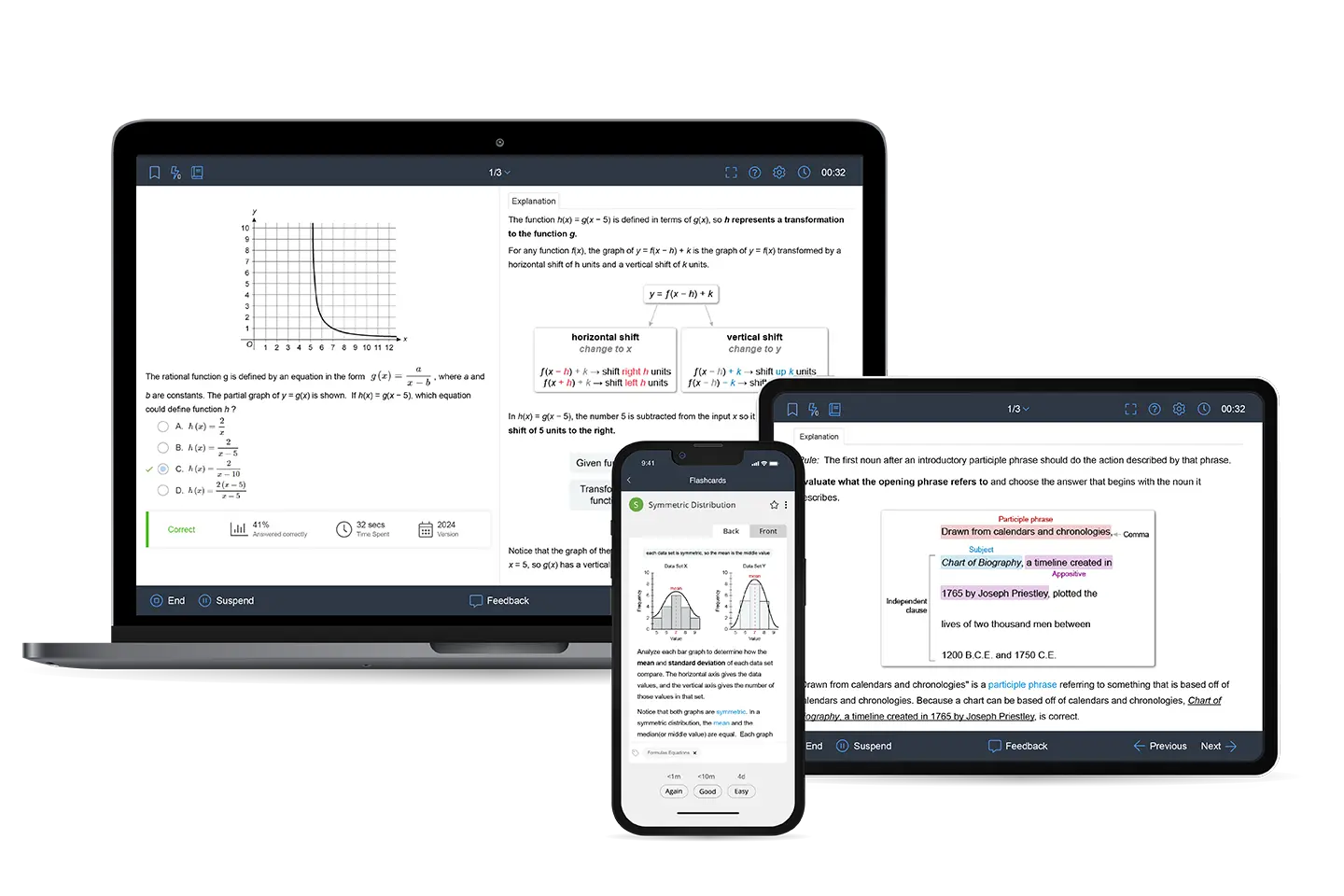
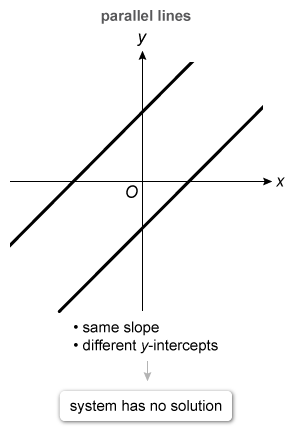





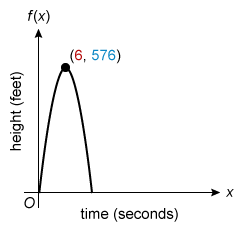
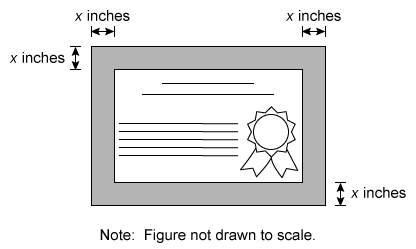
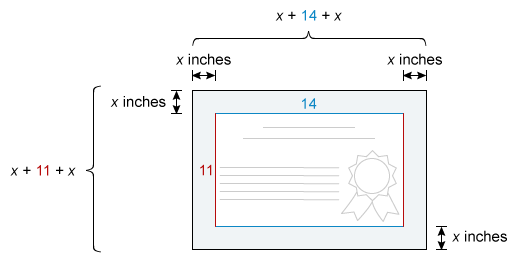


![Image ID: L60025; Click here to see more information Quadratic formula: x = [-b ± √(b² - 4ac)] / (2a)](https://collegeprep.uworld.com/wp-content/uploads/2025/10/L60025.webp)
